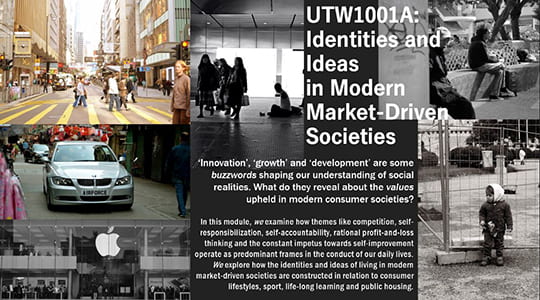Marissa K. L. E
Centre for English Language Communication (CELC)
Marissa discusses how she applied a learning activity in an Ideas and Exposition course to enhance students’ critical thinking and analytical capacities in the area of multimodal literacy.

E, M. K. L. (2023, February 16). Teaching critical thinking through multimodal literacy. Teaching Connections. https://blog.nus.edu.sg/teachingconnections/2023/02/16/critical-thinking-through-multimodal-literacy/
We live in an age where the creation and dissemination of multimodal artefacts like posters and videos have become commonplace. While language remains the primary mode of communication, the advent of new media has meant that language can combine with image and sound resources in “complex and changing ways” (O’Halloran et al., 2017, p. 147).
Audiences may find such complexity and change challenging when interpreting multimodal artefacts. This is especially if they lack a deeper understanding of the ways meanings are constructed and why. As Kress (2003) argues “It is no longer possible to think about literacy in isolation from a vast array of social, technological and economic factors” (p. 1).

With these considerations in mind, I offer here a brief description of a learning activity used in my UTW1001A course “Identities and Ideas in Modern Market-Driven Societies” that aims at developing students’ awareness and analytical abilities with regard to multimodal literacy. From my experience, students often assume the multimodal integration of semiotic (meaning) resources to be uncomplicated and neutral, when there is actually a need to think critically about how and why particular configurations of semiotic resources are used.
The learning activity involves students analysing a still image1 advertising the Singapore government’s vaccination campaign video featuring ‘Phua Chu Kang’ and ‘Rosie Phua’, popular characters from a local television show ‘PCK Private Limited’.

Using the Multimodal Analysis for Critical Thinking (MACT) framework (O’Halloran et al., 2017) in Figure 1, students were taught selected semiotic resources as analytical categories. This provided them with the vocabulary and scaffolding needed to systematically conduct and express the analysis (Lim-Fei et al., 2015). Table 1 (refer to Appendix A) shows the list of analytical categories taught, their definitions, and an example analysis for the category of colour scheme. These analytical categories are drawn from Kress and van Leeuwen (2006). Since most students would be unfamiliar with these analytical categories, I utilised other examples2 to introduce and model multimodal analysis prior to using Table 1 (see Appendix A).

Figure 1. MACT framework (adapted from O’Halloran et al., 2017)
Students worked in groups to analyse the vaccination video and present their analysis in class. Using the analyses presented, which centred on the humour and welcoming tone of the video, students were asked to consider why the video adopted a humorous slant even with the severity of the COVID-19 pandemic. This helped initiate student discussion about the rationale for the way the video was semiotically constructed. Students observed how humour worked to make the prospect of being vaccinated less daunting. Another interesting student observation was how context matters when developing communication material. More specifically, with so much that was unknown about COVID-19 then, and the daily announcements of rising case and death rates, using humour could provide relief and represent vaccination as a way out of the pandemic.
We then contrasted this with the week’s assigned reading, which examined how diabetes prevention public health communication posters in the United Kingdom utilised fear and grief to motivate its audience to be pro-active in preventing diabetes. This helped students see how public health messages could be communicated differently depending on purpose and context.
This learning activity involves applying the critical thinking skills of interpretation, analysis, inference, evaluation, and explanation (Facione et al., 1995). Students have to interpret and analyse the multimodal artefact provided, infer meanings based on their analysis, and evaluate and explain the analysis with awareness of the socio-cultural and socio-political context surrounding the artefact. This type of critical examination can appeal to students, as evidenced in the following student feedback:
“I've learnt useful analysis methods such as multimodal analysis to properly understand why certain analytical elements support my arguments.”
Student work also evidences the utility of multimodal analysis in facilitating the application of critical thinking. Appendix B shows an extract from a student’s final assignment submission, together with annotations indicating parts of the extract relevant to the student’s application of multimodal analysis. His assignment focused on the multimodal analysis of communication material from the Singapore government’s ‘Made for Families’ campaign. This campaign aims to communicate and increase public awareness of the various government initiatives to support families3.
In this extract, the student analysed an image4 from the ‘Made for Families’ website to argue for how property ownership is framed by the Singapore state as a form of incentivisation to encourage couples to have children. We can see how he interpreted and analysed the various elements in the image using most of the analytical categories in Table 1, and from there inferred the use of emotive appeal to the audience, explaining how it acts as a form of incentivisation since it appeals to what the intended audience of the image likely desires.
It is important to note that this image only formed part of his analysis and served primarily to show the government’s support for home ownership among couples, which would help ease their financial burden and possibly influence couples’ decision-making on whether to have children or not.
While one might assume that multimodal literacy can be developed amongst students via mere exposure to multimodal artefacts, the reality can be quite different. For example, one of the challenges faced when conducting this activity was some degree of student scepticism regarding interpretation, since it involves a degree of subjectivity that comes with analysing a medium that does not have explicitly defined ‘rules’ like language grammar. This scepticism is quite ironic since the students are themselves interpreting meaning from multimodal artefacts in daily life, which means that there must be some rule-based comprehension occurring. Thus, it is quite clear that there is a need to teach multimodal literacy, and to link this to critical examinations on how our societies communicate and function.
Endnotes
- See the video here: https://www.timeout.com/singapore/news/steady-pom-pi-pi-singapores-favourite-phua-chu-kang-is-back-to-help-boost-vaccinations-050621.
- See the example here: https://www.hellokpop.com/news/mcdonalds-to-launch-bts-meal-around-the-world-starting-may/.
- ‘Families’ is understood here as the state-sanctioned understanding of the ‘family’ in the Singapore context as consisting of one male individual and one female individual.
- See the image here under the category of ‘Housing’ on the webpage: https://www.madeforfamilies.gov.sg/resources/didyouknow?category=all
References
Facione, P. A., Sanchez, C. A., Facione, N. C., & Gainen, J. (1995). The disposition toward critical thinking. The Journal of General Education, 44(1), 1-25. http://www.jstor.org/stable/27797240
Jewitt, C. (2008). Multimodality and literacy in school classrooms. Review of Research in Education, 32(1), 241-267. https://doi.org/10.3102%2F0091732X07310586
Kress, G. (2003). Literacy in the new media age. Routledge.
Kress, G., & van Leeuwen, T. (2006). Reading images: The grammar of visual design. Routledge.
Lim Fei, V., O’Halloran, K. L., Tan, S., & E, M. K. L. (2015). Teaching visual texts with the multimodal analysis software. Education Technology Research and Development, 63, 915–935. https://doi.org/10.1007/s11423-015-9395-4
O’Halloran, K. L., Tan, S., & E, M. K. L. (2017). Multimodal analysis for critical thinking. Learning, Media and Technology, 42(2), 147-170. https://doi.org/10.1080/17439884.2016.1101003
Appendix A. Analytical Categories for Multimodal Analysis
Table 1
Analytical categories for multimodal analysis
|
Category |
Definition |
Analysis |
|
Colour scheme |
Type of colour used, e.g. bright vs. dull colours |
Yellow, white and orange – bright to attract attention and convey optimism, also references PCK’s yellow-coloured construction boots and its meanings of humour |
|
Gaze |
Direct (Looks at viewer): Demands viewers’ attention |
|
|
Shot Distance |
Long Shot: Whole body of the person can be seen |
|
| Posture and Gesture | Centred: Person faces viewer directly Angled: Person faces viewer at an angle |
|
| Focus | Degree to which a part or element of the image is blurred or in focus (sharpness) | |
| Composition (Size and position) |
Size of elements in the image |
|
Appendix B. Extract from Student Work

 |
Marissa E is a Senior Lecturer at CELC and coordinates the NUS University Town Writing Programme. Her research interests include systemic functional linguistics, critical multimodal discourse studies and conceptual metaphor theory. She has published and presented in the areas of social semiotics, multimodal discourse analysis, critical discourse studies, multiliteracies and the use of multimodality for education. Marissa can be reached at elcmari@nus.edu.sg. |

